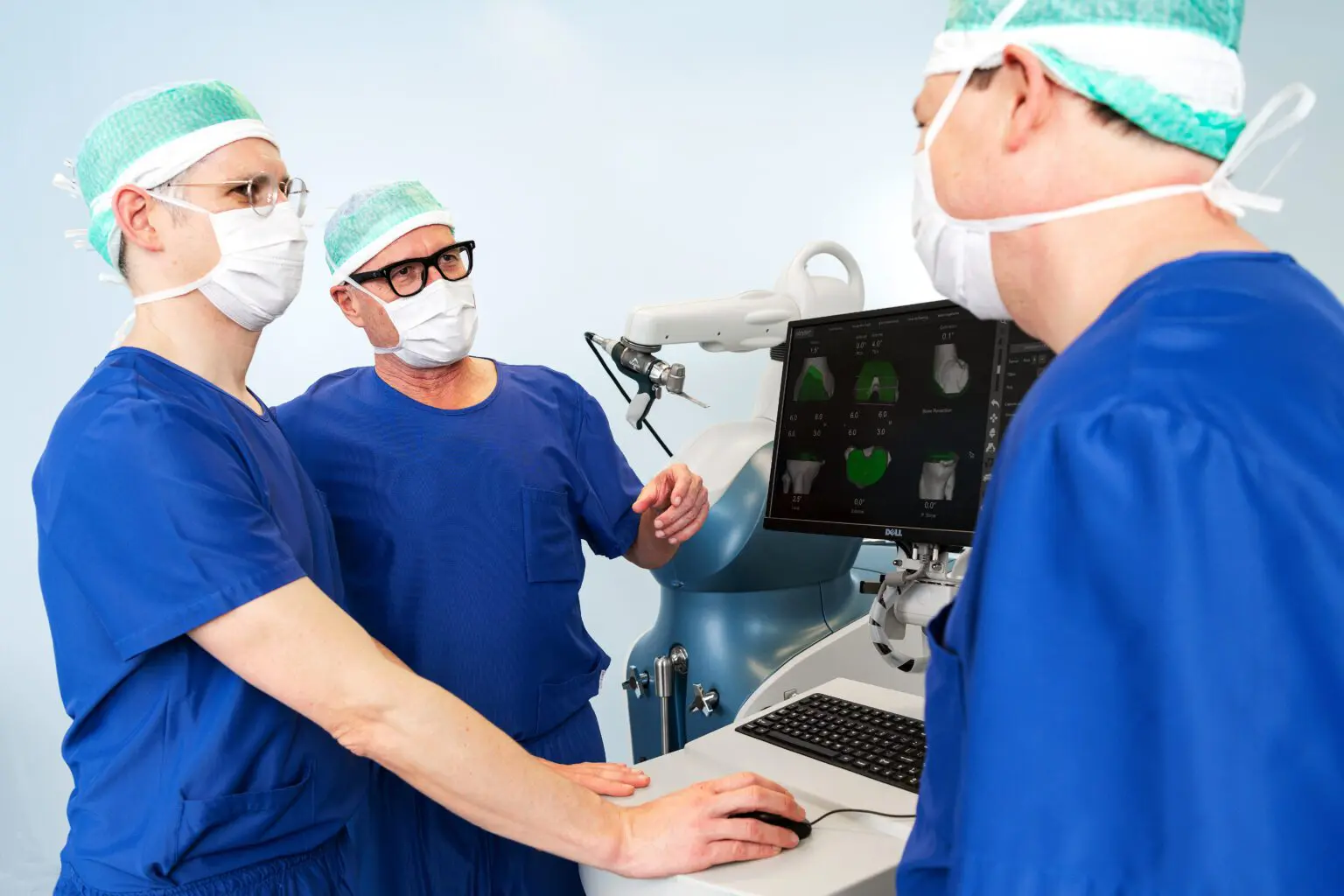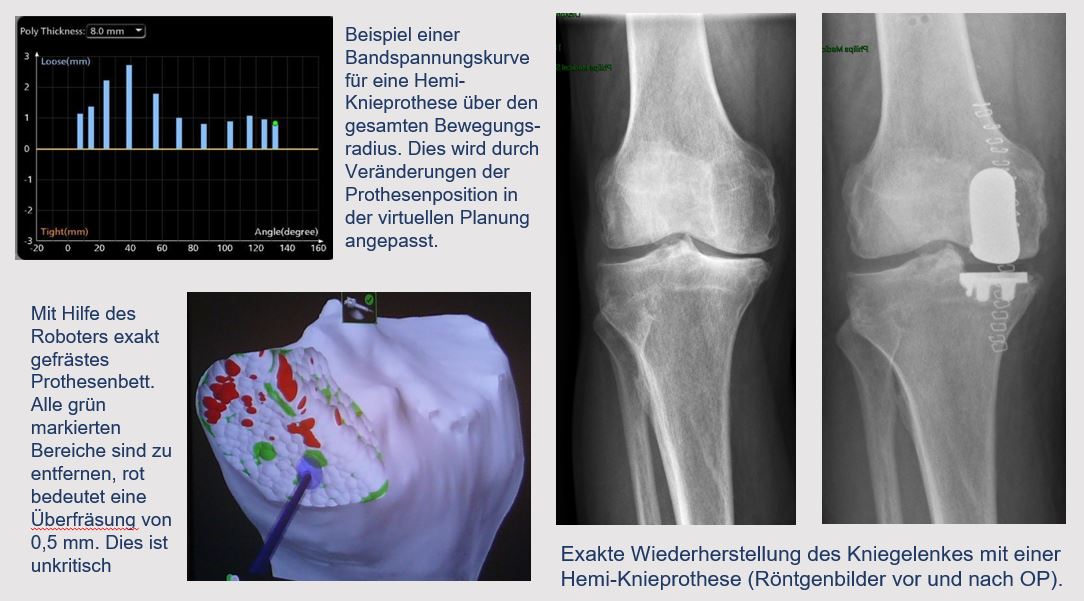
Today, we perform 95% of knee operations with robotic assistance and already have experience of over 3000 such operations.
Our articon practice is one of the pioneers of computer-assisted and robot-assisted surgery in Europe. We have been using computer-assisted procedures for prosthesis implantation for over 10 years.
In a study published in 2021, we were able to show that rehabilitation after a total prosthesis is faster if we can reconstruct the knee joint exactly anatomically with the prosthesis using robot-assisted 3D planning. In another research study, we showed that the use of MAKO technology leads to a reduction in complications with knee prostheses, especially partial prostheses (up to 75%).
What does robot-assisted knee prosthesis implantation mean?
Various “surgical robot systems” are now available for the implantation of knee prostheses. The term “robot-assisted” refers to a range of technologies that are designed to increase the precision of the operation and avoid surgical errors. However, the systems still differ significantly in terms of technology.
The MAKO technology we use is the only robotic system that works with prior CT planning. This allows us to plan the prosthesis precisely before the operation and take into account the individual characteristics of your knee joint. Although the saw is activated and guided by the surgeon during the operation, the robot controls the sawing plane precisely and prevents deviations. This also protects the surrounding tissue and reduces injury. Surgical errors are minimized by the robotic application.
Our MAKO robotic system is the only one with which we can operate on partial knee prostheses, total knee prostheses and hip prostheses and even perform replacement operations on artificial joints.
How does MAKO robotic arm-assisted surgery work?
In preparation for a MAKO operation, a computer tomography scan of the affected joint or leg is first carried out. This usually takes place around 2 weeks before the operation and is carried out at the Salem Hospital, as we have the certified equipment for this. The examination itself only takes a few minutes. Before the operation, a team of specialists will use these images to create a virtual, three-dimensional model of your joint on the computer and carry out initial planning of the operation. This model and the planning are then shown to the surgeon. The surgeon can follow all the planning steps and, if necessary, adapt or optimize the surgical planning to your needs.

With this planning, the operation can begin. The entire preparation for the operation is no different from our other standard procedures, particularly with regard to the anesthetic procedure or operation time. First and foremost, with the robot, the camera and the workstation, there is more technical equipment in the operating theater than usual. While you are still preparing for the operation, the computer in the operating theater is booted up and the robotic arm is calibrated. This is always done by a specially trained employee of the manufacturer who accompanies each MAKO operation from start to finish. They are driven into the operating theater, where everything is already set up and prepared.
In the next step – and this is specific to all computer-assisted surgical procedures – optical markers are attached to the upper and lower leg bones. Using these markers, the navigation system with infrared camera recognizes the position of your leg in space throughout the operation. The anatomy of your knee joint is then compared with the 3D bone model in the computer using movements and tactile instruments. This entire process takes less than 5 minutes. You now have a very precise image of your bone anatomy in the computer.

However, the information on the ligaments and soft tissue is still missing for the correct final adjustment of the prosthetic components on the knee joint. In the next step, the ligament tension in different positions of the joint is also read into the system. To do this, the surgeon moves the joint and saves the ligament stability. The initial surgical plan is then checked and fine-tuned in relation to the soft tissue. The aim is to reconstruct a joint that is stable over the entire range of motion with a movement sequence that is as natural as possible. Each individual parameter can be changed three-dimensionally in the 0.5 mm or 0.5° range. Only when this virtual planning has been optimized is the actual robotic arm moved to the operating table and set up. The MAKO robotic arm is now used to create the saw cuts or mill the prosthesis bed. The actual instrument is guided by the surgeon at all times.
The robot only specifies the correct and planned sawing level and prevents the saw from being set incorrectly. It also sets narrow limits for the instruments. Whenever the surgeon wants to leave the defined sawing area, the device stops automatically. This protects the surrounding soft tissue structures better than any hook. Once all the saw cuts have been made, the trial prosthesis can be inserted to check the correct fit and ligament stability once again. This is once again objectively evaluated by the computer. If there are any deviations, the system can be used to make corrections at any time. If everything goes according to plan, the original prosthesis is then inserted. This is followed by the usual wound closure and removal of the bone markings in the thigh and lower leg. The follow-up treatment and rehabilitation corresponds to our Optimal Recovery follow-up treatment scheme, whereby we often observe faster rehabilitation due to the soft tissue-sparing technique.
Additional payment for robot technology
At present, the robot-assisted technique and the associated additional costs are only covered by semi-private or private supplementary insurance. Patients with general insurance who opt for the MAKO technique must pay a deductible of CHF 1200.